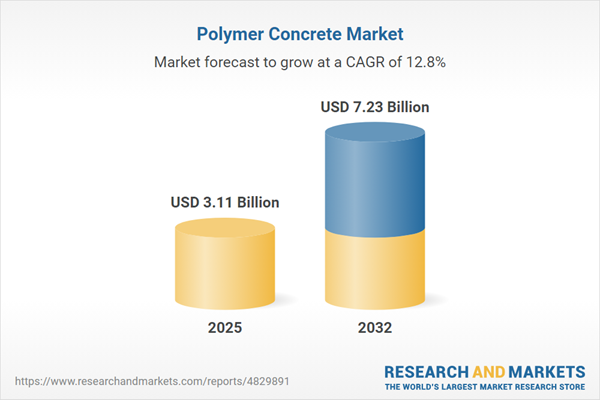Speak directly to the analyst to clarify any post sales queries you may have.
The polymer concrete market is experiencing robust growth as construction firms, infrastructure developers, and industry leaders increasingly seek high-performance materials that address modern demands for durability, efficiency, and sustainability. This report provides senior decision-makers with a strategic, actionable overview grounded in industry-driven research and practical advances.
Market Snapshot: Polymer Concrete Market Overview
The Polymer Concrete Market grew from USD 2.75 billion in 2024 to USD 3.11 billion in 2025. It is expected to continue growing at a CAGR of 12.83%, reaching USD 7.23 billion by 2032.
Scope & Segmentation
- Resin Type: Epoxy, Polyester (Isophthalic, Orthophthalic), Vinyl Ester (Bisphenol, Novolac)
- Application: Flooring Systems, Commercial Floors, Decorative Floors, Industrial Floors, Precast Products, Primers and Sealers, Repair and Rehabilitation
- End Use: Commercial, Industrial, Residential
- Regional Coverage:
- Americas: United States, Canada, Mexico, Brazil, Argentina, Chile, Colombia, Peru
- Europe, Middle East, & Africa: United Kingdom, Germany, France, Russia, Italy, Spain, Netherlands, Sweden, Poland, Switzerland, United Arab Emirates, Saudi Arabia, Qatar, Turkey, Israel, South Africa, Nigeria, Egypt, Kenya
- Asia-Pacific: China, India, Japan, Australia, South Korea, Indonesia, Thailand, Malaysia, Singapore, Taiwan
- Leading Companies: Sika AG, BASF SE, MAPEI S.p.A., Fosroc International Limited, RPM International Inc., GCP Applied Technologies Inc., LATICRETE International, Inc., Chryso SA, Pidilite Industries Limited, XYPEX Chemical Corporation
Key Takeaways
- Polymer concrete’s value proposition centers on its ability to enhance project resilience, accelerate construction schedules, and facilitate environmentally responsible solutions across infrastructure, industrial, and high-end residential markets.
- Continuous resin innovation and rapid-curing technologies are being adopted, allowing for more robust mechanical performance, improved chemical resistance, and customized solutions for region-specific or sector-driven needs.
- Industry momentum is shifting toward collaborative innovation, as suppliers and customers co-develop new formulations and share performance data to ensure the material meets evolving regulatory and operational standards.
- Digital tools and advanced data analytics increasingly enable design optimization, support lifecycle assessments, and provide transparency in material sourcing and supply chain management.
- Emerging environmental mandates and a focus on circular economy principles are driving increased adoption of bio-based and recycled polymers, with key players investing in sustainable R&D platforms to future-proof portfolios.
Tariff Impact and Supply Chain Adaptation
Recent tariff adjustments on imported polymer resins and aggregates have resulted in shifts across the value chain. Producers and contractors are renegotiating supplier agreements, diversifying procurement to localize feedstock sourcing, and exploring alternative composite formulations. These market adjustments highlight the necessity for resilient supply strategies and contingency planning, particularly for organizations reliant on cross-border imports or volatile raw material pricing. Trials with bio-resins and recyclable blends are showing promising results for core applications, allowing early movers to maintain predictable cost structures even amid changing trade environments.
Methodology & Data Sources
This report combines structured executive interviews, a dedicated online market survey, and comprehensive secondary research. The approach draws on technical white papers, journal articles, standards documents, company disclosures, and a proprietary database of application case studies, ensuring objectivity and broad validation through data triangulation and statistical scenario analysis.
Why This Report Matters
- Enables strategic alignment by equipping executive teams with informed, data-backed insights into evolving market drivers, technology trends, and regulatory impacts in the polymer concrete market.
- Delivers actionable segmentation detail for targeted investment, product development, or expansion strategies across regions and end-use sectors.
Conclusion
The polymer concrete market is poised for transformation as innovation, sustainability, and regulation shape supply and demand. Stakeholders ready to embrace change can drive differentiation, risk mitigation, and sustained growth through informed decisions grounded in this research.
Additional Product Information:
- Purchase of this report includes 1 year online access with quarterly updates.
- This report can be updated on request. Please contact our Customer Experience team using the Ask a Question widget on our website.
Table of Contents
3. Executive Summary
4. Market Overview
7. Cumulative Impact of Artificial Intelligence 2025
Companies Mentioned
The companies profiled in this Polymer Concrete market report include:- Sika AG
- BASF SE
- MAPEI S.p.A.
- Fosroc International Limited
- RPM International Inc.
- GCP Applied Technologies Inc.
- LATICRETE International, Inc.
- Chryso SA
- Pidilite Industries Limited
- XYPEX Chemical Corporation
Table Information
| Report Attribute | Details |
|---|---|
| No. of Pages | 186 |
| Published | October 2025 |
| Forecast Period | 2025 - 2032 |
| Estimated Market Value ( USD | $ 3.11 Billion |
| Forecasted Market Value ( USD | $ 7.23 Billion |
| Compound Annual Growth Rate | 12.8% |
| Regions Covered | Global |
| No. of Companies Mentioned | 11 |









